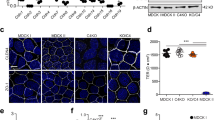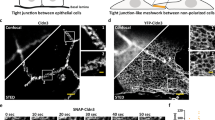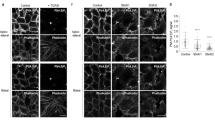Abstract
The tight junction (zonula occludens) links epithelial cells into a monolayer by forming a continuous belt of sealing contacts around the apex of each cell. They appear in thin sections as if they were ‘fusions’ between the apposed plasma membranes1 and in freeze-fracture replicas as patterns of complementary strands and furrows2. These images have led to the proposal that the core of the tight junction is formed by a hexagonal cylinder of lipids3,4. In this model, the cytoplasmic leaflet of the apical and basolateral plasma membrane domains would be continuous, whereas the exoplasmic leaflets of the two plasma membrane domains of the same cell would be separated at the tight junction and are instead predicted to be continuous between the plasma membranes of neighbouring cells. We demonstrate here that this prediction does not hold true. An endogenous glycolipid (Forssman antigen), present in the exoplasmic leaflet of the apical membrane of MDCK strain II cells5,6, is unable to pass to MDCK strain I cells (which lack this glycolipid) under conditions where these cells are connected by tight junctions. In addition, fluorescent lipids which have been fused into the plasma membrane7,8 of one MDCK cell do not diffuse to neighbouring cells while the tight junctions between the cells are intact.
This is a preview of subscription content, access via your institution
Access options
Subscribe to this journal
Receive 51 print issues and online access
$199.00 per year
only $3.90 per issue
Buy this article
- Purchase on Springer Link
- Instant access to full article PDF
Prices may be subject to local taxes which are calculated during checkout
Similar content being viewed by others
References
Farquhar, M. G. & Palade, G. E. J. Cell Biol. 17, 375–412 (1963).
Goodenough, D. A. & Revel, J. P. J. Cell Biol. 45, 272–290 (1970).
Kachar, B. & Reese, T. S. Nature 296, 464–466 (1982).
Pinto da Silva, P. & Kachar, B. Cell 28, 441–450 (1982).
Hansson, G. C., Simons, K. & & van Meer, G. EMBO J. 5, 483–489 (1986).
Nichols, G. E., Lovejoy, J. C., Borgman, C. A. & Young, W. W. Jr J. Cell Biol. 101, 64a (1985).
van Meer, G. & Simons, K. J. Cell Biol. 97, 1365–1374 (1983).
van Meer, G., Davoust, J. & Simons, K. Biochemistry 24, 3593–3602 (1985).
Balcarova-Ständer, J., Pfeiffer, S. E., Fuller, S. D. & Simons, K. EMBO J. 3, 2687–2694 (1984).
Gumbiner, B. & Simons, K. J. Cell Biol. 102, 457–468 (1986).
Sonnenberg, A. et al. J. Immun. (in the press).
Struck, D. K., Hoekstra, D. & Pagano, R. E. Biochemistry 20, 4093–4099 (1981).
Hoekstra, D., de Boer, T., Klappe, K. & Wilschut, J. Biochemistry 23, 5675–5681 (1984).
Fuller, S., von Bonsdorff, C.-H. & Simons, K. Cell 38, 65–77 (1984).
Cereijido, M., Robbins, E. S., Dolan, W. J., Rotunno, C. A. & Sabatini, D. D. J. Cell Biol. 77, 853–880 (1978).
van Meer, G. & Simons, K. EMBO J. 5, 1455–1464 (1986).
Dragsten, P. R., Blumenthal, R. & Handler, J. S. Nature 294, 718–722 (1981).
Stevenson, B. R. & Goodenough, D. A. J. Cell Biol. 98, 1209–1221 (1984).
Szoka, F. Jr & Papahadjopoulos, D. Proc. natn. Acad. Sci. U.S.A. 75, 4194–4198 (1978).
Author information
Authors and Affiliations
Rights and permissions
About this article
Cite this article
van Meer, G., Gumbiner, B. & Simons, K. The tight junction does not allow lipid molecules to diffuse from one epithelial cell to the next. Nature 322, 639–641 (1986). https://doi.org/10.1038/322639a0
Received:
Accepted:
Issue Date:
DOI: https://doi.org/10.1038/322639a0
This article is cited by
-
Characterization and molecular evolution of claudin genes in the Pungitius sinensis
Journal of Comparative Physiology B (2020)
-
Tight junctions: from simple barriers to multifunctional molecular gates
Nature Reviews Molecular Cell Biology (2016)
-
Regulation of tight junctions by sex hormones in normal human endometrial epithelial cells and uterus cancer cell line Sawano
Cell and Tissue Research (2013)
-
Epidermal growth factor modulates claudins and tight junctional functions in ovarian cancer cell lines
Histochemistry and Cell Biology (2012)
-
Large neutral amino acids supplementation in phenylketonuric patients
Journal of Inherited Metabolic Disease (2009)
Comments
By submitting a comment you agree to abide by our Terms and Community Guidelines. If you find something abusive or that does not comply with our terms or guidelines please flag it as inappropriate.



